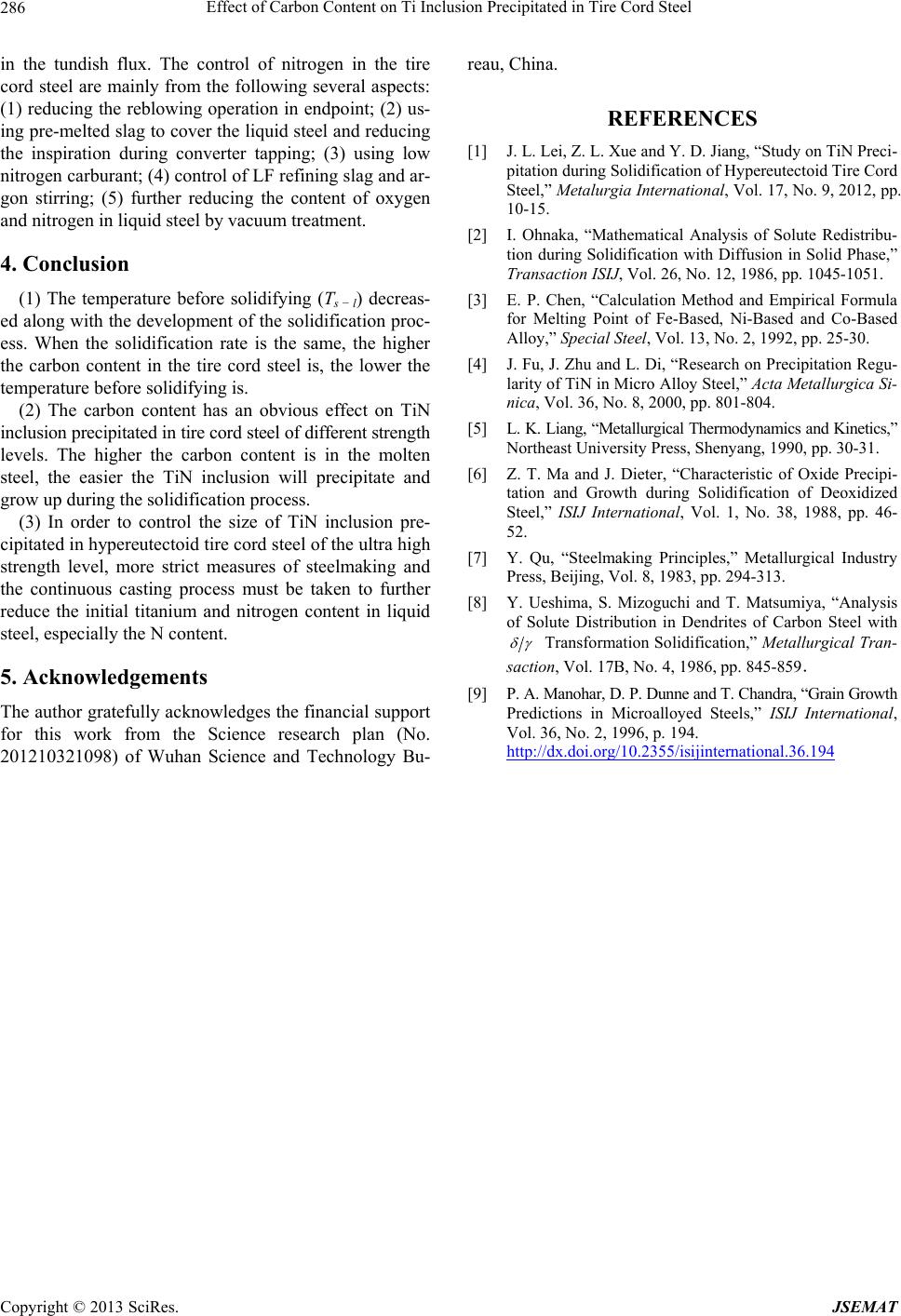
Effect of Carbon Content on Ti Inclusion Precipitated in Tire Cord Steel
286
in the tundish flux. The control of nitrogen in the tire
cord steel are mainly from the following several aspects:
(1) reducing the reblowing operation in endpoint; (2) us-
ing pre-melted slag to cover the liquid steel and reducing
the inspiration during converter tapping; (3) using low
nitrogen carburant; (4) control of LF refining slag and ar-
gon stirring; (5) further reducing the content of oxygen
and nitrogen in liquid steel by vacuum treatment.
4. Conclusion
(1) The temperature before solidifying (Ts − l) decreas-
ed along with the development of the solidification proc-
ess. When the solidification rate is the same, the higher
the carbon content in the tire cord steel is, the lower the
temperature before solidifying is.
(2) The carbon content has an obvious effect on TiN
inclusion precipitated in tire cord steel of different strength
levels. The higher the carbon content is in the molten
steel, the easier the TiN inclusion will precipitate and
grow up during the solid ification process.
(3) In order to control the size of TiN inclusion pre-
cipitated in hypereutectoid tire cord steel of the ultra high
strength level, more strict measures of steelmaking and
the continuous casting process must be taken to further
reduce the initial titanium and nitrogen content in liquid
steel, especially the N content.
5. Acknowledgements
The author gratefully acknowledges the financial support
for this work from the Science research plan (No.
201210321098) of Wuhan Science and Technology Bu-
reau, China.
REFERENCES
[1] J. L. Lei, Z. L. Xue and Y. D. Jiang, “Study on TiN Preci-
pitation during Solidification of Hypereutectoid Tire Cord
Steel,” Metalurgia International, Vol. 17, No. 9, 2012, pp.
10-15.
[2] I. Ohnaka, “Mathematical Analysis of Solute Redistribu-
tion during Solidification with Diffusion in Solid Phase,”
Transaction ISIJ, Vol. 26, No. 12, 1986, pp. 1045-1051.
[3] E. P. Chen, “Calculation Method and Empirical Formula
for Melting Point of Fe-Based, Ni-Based and Co-Based
Alloy,” Special Steel, Vol. 13, No. 2, 1992, pp. 25-30.
[4] J. Fu, J. Zhu and L. Di, “Research on Precipitation Regu-
larity of TiN in Micro Alloy Steel,” Acta Metallurgica Si-
nica, Vol. 36, No. 8, 2000, pp. 801-804.
[5] L. K. Liang, “Metallurgical Ther modynamics and Ki netics,”
Northeast University Press, Shenyang, 1990, pp. 30-31.
[6] Z. T. Ma and J. Dieter, “Characteristic of Oxide Precipi-
tation and Growth during Solidification of Deoxidized
Steel,” ISIJ International, Vol. 1, No. 38, 1988, pp. 46-
52.
[7] Y. Qu, “Steelmaking Principles,” Metallurgical Industry
Press, Beijing, Vol. 8, 1983, pp. 294-313.
[8] Y. Ueshima, S. Mizoguchi and T. Matsumiya, “Analysis
of Solute Distribution in Dendrites of Carbon Steel with
Transformation Solidification,” Metallurgical Tran-
saction, Vol. 17B, No. 4, 1986, pp. 845-859.
[9] P. A. Manohar, D. P. Dunne and T. Chandra, “Grai n Growt h
Predictions in Microalloyed Steels,” ISIJ International,
Vol. 36, No. 2, 1996, p. 194.
http://dx.doi.org/10.2355/isijinternational.36.194
Copyright © 2013 SciRes. JSEMAT